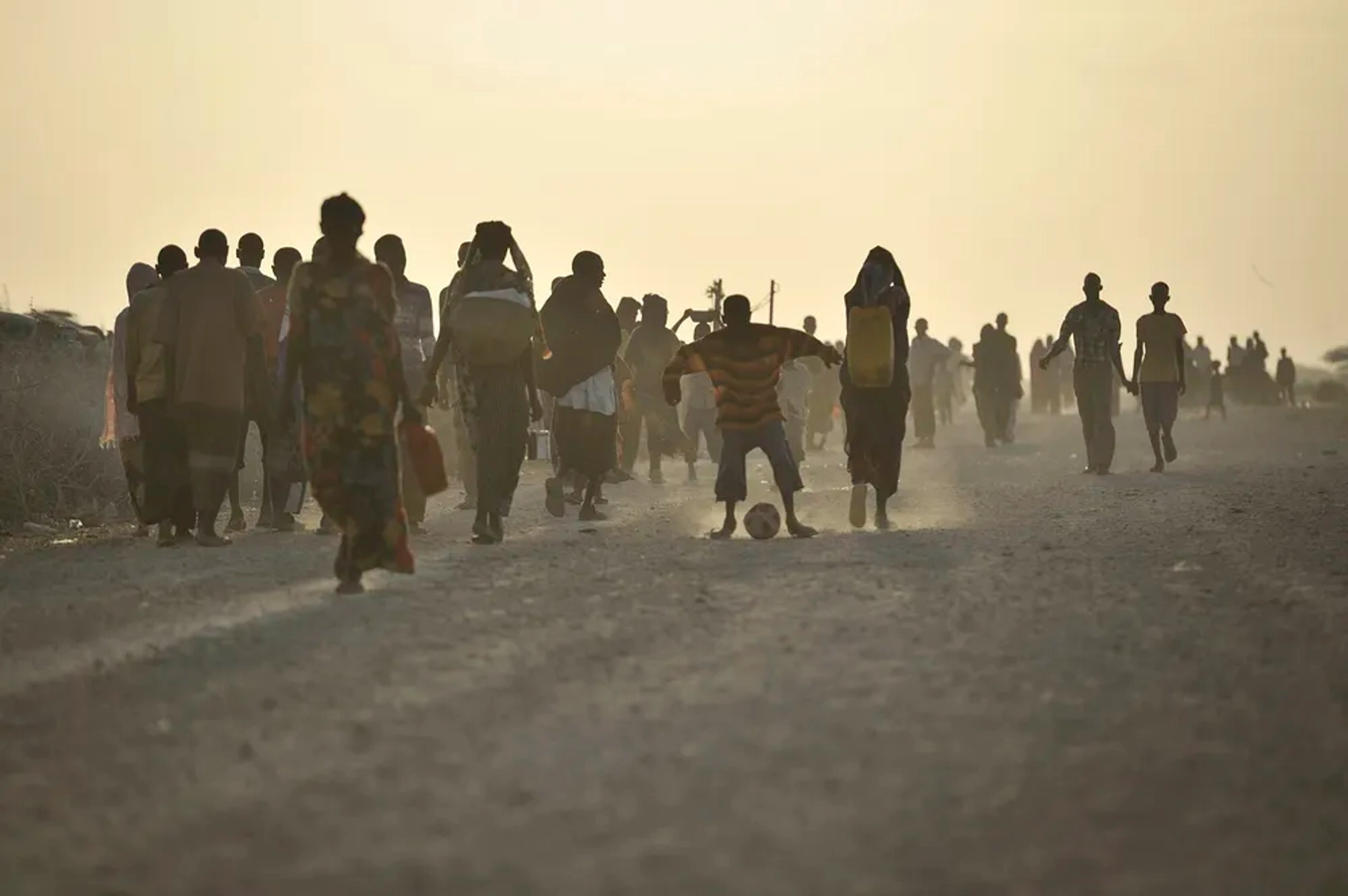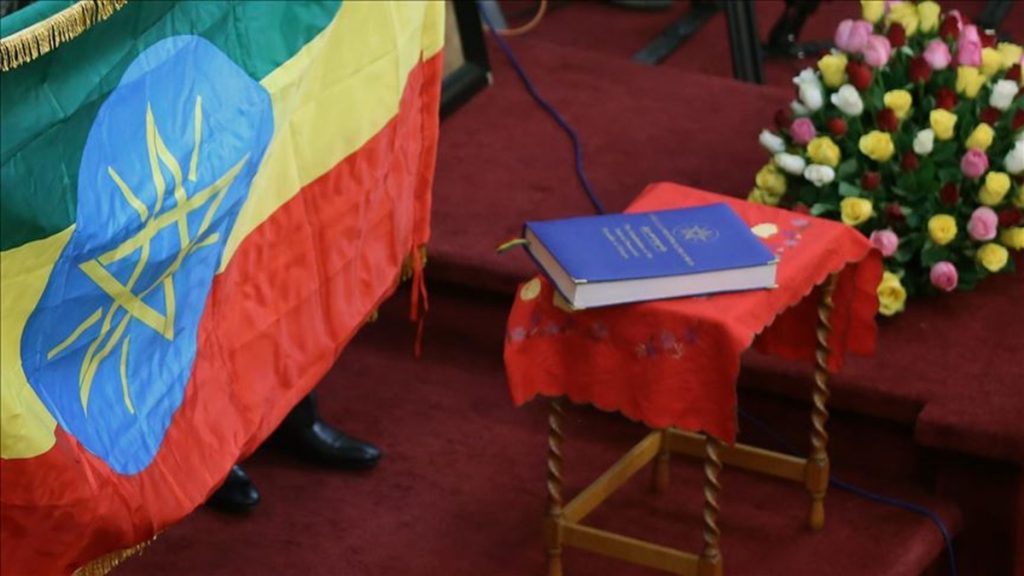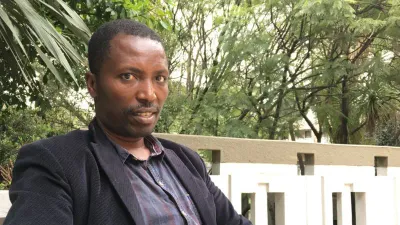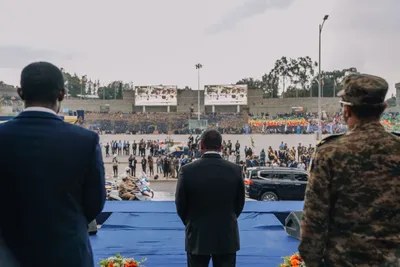Why Ethiopia’s Crisis Could Unleash the World’s Next Displacement Catastrophe

A young boy plays football on a road at an IDP camp near the town of Jowhar, Somalia, on December 14. Source: The African Union Mission in Somalia.
The Horn of Africa stands at a geopolitical precipice. For decades, the region has weathered droughts, wars, and state collapses. Today, however, the convergence of internal authoritarianism, regional proxy wars, and unresolved national questions threatens to trigger a humanitarian and political implosion, one whose ripple effects could extend far beyond the continent. At the center of this crisis is Ethiopia, Africa’s second most populous country, where authoritarian consolidation, ethnonational repression, and militarized statecraft have fused into a combustible mix.
A Region Unraveling
The Horn’s security architecture has all but disintegrated. In Sudan, the devastating civil war that erupted in April 2023 has displaced nearly 10 million people internally and across borders. The conflict has shredded the fragile state, spilling instability into Chad, South Sudan, and Egypt, while simultaneously eroding regional humanitarian capacity. This conflict, rooted in internal causes, is fueled by external powers: the United Arab Emirates (UAE) is widely accused of backing the paramilitary Rapid Support Forces (RSF), while Saudi Arabia and Egypt have generally supported the Sudanese Armed Forces (SAF). Ethiopia has hands in all of these troubles. In a controversial move that has angered Khartoum, Addis Ababa has been accused of playing the UAE’s bidding by offering tacit support to the RSF, viewing the group’s rise as a means to gain leverage in the Nile dispute.
South Sudan’s own peace remains precarious, as factional struggles between President Salva Kiir and Vice President Riek Machar risk reigniting full-scale war and displacing millions more. The deepening rivalry between these two leaders poses a serious spillover risk from the Sudanese conflict, as regional actors may seek to back proxies in Juba. Since the beginning of this year, the renewed fighting between rival leaders’ forced over 300000 South Sudanese to cross over to neighbouring countries.
Somalia has become an arena for proxy confrontation. Reports of Egyptian troops landing in support of Somali factions have escalated tensions with Ethiopia, transforming the country into a potential battleground in a broader geopolitical contest. This move is a clear escalation in the direct confrontation between Egypt and Ethiopia over the use of the Nile, with Cairo leveraging Somalia’s sovereignty dispute with Addis Ababa as a strategic counter-move. This is layered atop Somalia’s chronic internal displacement crisis, with 3.9 million people already uprooted. The prospect of direct Ethiopian-Egyptian confrontation on Somali soil underscores the extent to which regional rivalries now intersect with internal fragilities.
Ethiopia: From Domestic Crisis to Regional Epicentre
Ethiopia is the epicentre of this unravelling — a state of over 130 million people whose collapse would dwarf the Syrian displacement crisis and reshape global migration dynamics. The country is simultaneously battling insurgencies, proxy conflicts, and irredentist ambitions, each contributing to an already staggering internal displacement figure of 4.4 million people.
Internal Fragmentation and the Rise of Proxy War
Two of Ethiopia’s most populous regions, Oromia and Amhara, are engulfed in armed conflict. In Oromia, the government’s counter-insurgency against the Oromo Liberation Army (OLA) has resulted in mass displacement, extrajudicial killings, and collective punishment, deepening the alienation of the Oromo people — the country’s largest ethnic group. 1 Abeshu, G. Conflict and Displacement Crisis Barely Making International Headlines: The Case of the Four Wollega Zones in Oromia Regional State in Ethiopia. Journal of Oromo Studies, 30 2 Amnesty International. (2024). Ethiopia: Oromia crisis report
In Amhara, federal forces are locked in a brutal confrontation with the Fano militia, a conflict complicated by allegations of external support and intra-elite rivalries.
The 2022 peace deal with the Tigray People’s Liberation Front (TPLF) has frayed, replaced by a dangerous proxy dynamic. Elements of the Tigray Defence Force are reportedly backing Fano fighters against the federal army, while Addis Ababa is accused of supporting TPLF factions operating from Afar. These entanglements transform Ethiopia’s conflicts into multi-layered proxy wars that now destabilize the entire northern half of the country.
The Geopolitics of the Nile: The GERD Existential Crisis
The dispute over the Grand Ethiopian Renaissance Dam (GERD) represents an existential threat to Egypt and a sovereignty project for Ethiopia, pushing the two nations toward confrontation. Egypt’s long-standing policy of opposition to the GERD has intensified, now including covertly supporting armed opposition groups in Ethiopia as a means of destabilization. 3 Clapham, C. (2023). The Horn of Africa: State, society and international politics. Ohio University Press The regional configuration of support is volatile: Ethiopia has deepened its strategic and economic partnership with the UAE, while Egypt is actively strengthening alliances with Somalia and, allegedly, with Eritrea to create a hostile perimeter around Ethiopia.

The gravity of this confrontation was highlighted by Egyptian President Abdel Fattah El-Sisi’s recent remarks on October 12, 2025. Speaking at the “Cairo Water Week,” El-Sisi issued a stark warning to Ethiopia, accusing it of causing “significant harm” to downstream nations through “irresponsible behavior” and “releasing irregular waters without prior notification or coordination”. He emphasized that Egypt’s water security is an “existential issue” and vowed that Cairo would not “stand idly” and is prepared to take “any and all necessary steps” to protect its vital water interests and its share of the Nile. El-Sisi rejected Ethiopian claims of “exclusive sovereignty over the Nile,” asserting that the river is a shared resource that must be governed by a legally binding agreement. This hardening rhetoric signals that years of diplomacy have failed, pushing the conflict into a more dangerous and confrontational phase.
The Red Sea Question: Maritime Ambition and War
Prime Minister Abiy Ahmed’s declaration that access to the Red Sea is an “existential necessity” for Ethiopia has brought Addis Ababa and Asmara perilously close to renewed war. The demand for sovereign access, particularly through Eritrea’s port of Assab, revives old hostilities from the 1998–2000 border conflict. Both governments now accuse each other of war preparations and support for opposition groups. If hostilities resume, the conflict would merge external territorial ambitions with Ethiopia’s internal fragmentation — a scenario likely to trigger massive refugee flows and redraw the geopolitical landscape of the Horn. Renewed war with Eritrea could transform the Red Sea corridor — already one of the world’s most militarized waterways — into a flashpoint for global powers.
The Oromo Question: The Key to Preventing Collapse
At the heart of Ethiopia’s instability lies the unresolved Oromo question. The Oromo, the largest ethnic group in Ethiopia and the wider Horn, have been systematically excluded from political power since the late 19th-century imperial expansion.(Jalata, A. (2023). Oromia and Ethiopia: State formation and ethnonational conflict, 1868-1992. Lynne Rienner Publishers)) 4 Bulcha, M. (2002). The making of the Oromo diaspora: A historical sociology of migration. The Red Sea Press The Oromo homeland forms the hydrological backbone of the Horn. Its rivers — including the Shebelle, which flows into Somalia; the Awash, which sustains the Afar lowlands; and tributaries that feed the Blue Nile — are vital to downstream countries such as Somalia, Djibouti, and Sudan. As such, resolving the Oromo question is not only a matter of justice but also of regional stability and environmental security.

A democratic settlement that addresses Oromo self-determination could transform Ethiopia from a destabilizing force into a cornerstone of cooperative water governance and conflict resolution in the Nile Basin. Without such a transformation, the imperial state’s repressive grip will continue to fuel rebellion and state fragmentation. The ongoing crisis is not simply a failure of governance — it is the inevitable outcome of an exclusionary political order. Only dismantling this imperial system and replacing it with a truly inclusive political structure can avert the impending collapse. The Oromo question, long sidelined by both domestic elites and international actors, is therefore central to any meaningful peace and stability in the region.
The Geopolitics of Displacement: A Looming Global Crisis
The implications of Ethiopia’s collapse extend far beyond the Horn. A disintegration scenario could generate tens of millions of refugees and internally displaced persons — surpassing the Syrian crisis and overwhelming global humanitarian capacity. Such a wave would place enormous pressure on neighboring states like Kenya, Sudan, and Djibouti, destabilize migration governance in the Middle East and Europe, and reshape and the United States’ asylum landscapes.
Moreover, the collapse of Ethiopia would have cascading effects on Nile Basin geopolitics. Disruption to the Blue Nile’s flow would heighten tensions with Egypt and Sudan, potentially internationalizing the conflict. Simultaneously, renewed war with Eritrea could transform the Red Sea corridor — already one of the world’s most militarized waterways — into a flashpoint for global powers.
International Complacency and the Urgent Need for Action
Despite these warning signs, international responses remain fragmented and reactive. Humanitarian aid is failing to keep pace with escalating displacement, while diplomatic initiatives have been piecemeal and ineffectual. Western governments, preoccupied with crises elsewhere, have largely ignored Ethiopia’s slide into authoritarianism and conflict. This inaction reflects a broader failure to understand the structural roots of the crisis — particularly the unresolved national questions, imperial state formation, and ethnonational exclusion that underpin it. 5 Markakis, J. (2011). National and class conflict in the Horn of Africa. Cambridge University Press. 6 Clapham, C. (2023). The Horn of Africa: State, society and international politics. Ohio University Press.
A meaningful response must move beyond crisis containment. It requires three urgent shifts:
- Reframing the Crisis as Political, Not Merely Humanitarian: Ethiopia’s collapse is driven by an exclusionary political order. International actors must press for an inclusive political settlement that addresses the Oromo question ( and of other nations and nationalities) and dismantles the imperial state structure.
- Preventing a Red Sea and Nile Conflagration: A high-level diplomatic initiative must be launched to de-escalate tensions between Ethiopia and Eritrea, and crucially, to address the direct confrontation between Egypt and Ethiopia over the Nile, by ending the strategic support for armed groups. The stakes of a renewed border war are too high for the region and the global economy.
- Curbing Destabilizing Regional Actors: International efforts must address the role of regional powers, specifically holding the UAE and Saudi Arabia accountable for fueling the civil war in Sudan and other proxy conflicts across the Horn.
Act Before Domino Falls
The Horn of Africa is poised on the edge of a catastrophic displacement crisis. The convergence of civil war in Sudan, proxy conflict in Somalia, and the unraveling of Ethiopia’s internal order is transforming localized emergencies into a systemic regional collapse. Ethiopia’s imperial state structure — the epicenter of these overlapping crises, and an actor increasingly engaging in its own geopolitical opportunism — must be dismantled and reimagined if the region is to find peace.
The Oromo question is central to this transformation. It is both a moral imperative and a geopolitical necessity. Resolving it could unlock pathways to internal peace, regional cooperation, and shared prosperity. Ignoring it guarantees further fragmentation, displacement, and instability. The international community must act now — not merely to avert a humanitarian disaster, but to support a just political settlement that addresses the structural roots of Ethiopia’s crisis. Anything less will condemn the Horn to a future defined by mass displacement, geopolitical rivalry, and preventable human suffering.
Footnotes
We need your support
We trust you found something of value in this article. If so, we kindly ask you to consider helping Curate Oromia continue its work.
If you believe in the importance of independent voices and honest reporting, we invite you to support our efforts through our GoFundMe campaign.
Every contribution, however small, goes directly to our writers and the expansion of our reach.
Thank you for your support.



